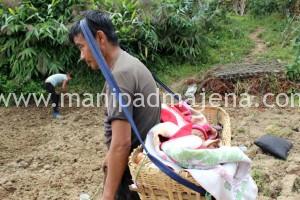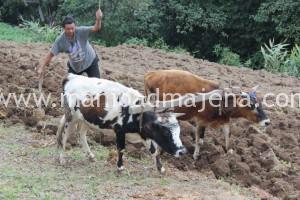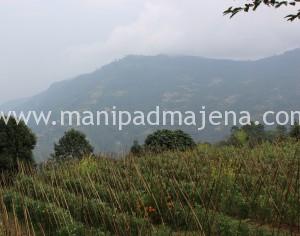
In Perbing village of South Sikkim 33- year-old Phurbayangi Sherpa, backpacking her pink-cheeked 3-month-old son Rabjan in a woven bamboo carrier, remembers of times when she turned eighteen and how groups of women and children from her village in the Indian Himalayan region, began trekking up to fetch drinking water from a hilltop mountain spring.
At first they needed to take the four-hour trek only in the March to May spring season, but there was no other way for them. The spring closer home was running dry those three months. Soon however the spring died and they had to trek up every day of the year.
Sikkim, an India state wedged between Nepal and Bhutan in the eastern Himalayan region, on average gets 300 centimetres of annual rain while Phurbayangi Sherpa’s village gets only 150cm because it lies in the Darjeeling Himalaya rain shadow region.
Exacerbating South Sikkim’s lower rainfall, it has experienced a 50 percent reduction in water flow from natural springs over the span of just the last ten years, says Sandeep Tambe, a key official of Sikkim government’s Rural Management and Development department which runs Dhara Vikas or spring-shed revival programme. Springs are locally called ‘dhara’.
“The impact of climate change is three times more on the Himalayas than elsewhere,” says Tambe.
“In Sikkim adaptation to climate change is all about water. It’s not glaciers but springs that ensure water and food security in changing climate here,” he adds.
Climate change and ecosystem degradation impact mountain springs and community
In villages like Perbing of Namthang, one the state’s eight drought prone blocks, dying springs had failed farmers and farm wage workers. The youth was migrating out to either join the armed forces or as road construction daily wage workers, leaving behind women doubly burdened. Women were tending to the farm, to elders and children beside forced to the extreme drudgery of fetching water from distances on steep terrain.
The oldest living person in Perbing, 75-year-old Lapka Rhelu living in her 150 year old wooden stilt house on a small hillock, said that she has seen times when harvests were plentiful, there was nothing lacking if one worked hard and the weather kept its timetable, but not anymore.
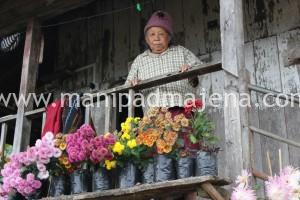
Frequency of winter droughts have increased with little or no rainfall received over the six months from October to March.
This climate variability observed over the last 20 years is compounded by catchment area degradation, deforestation, grazing and land-use change.
Also only one-tenth of the annual rainfall manages to infiltrate into the ground, Sikkim’s landscape being extremely steep, ranging from 300 metres up to the world’s third highest Mount Khangchendzonga at 8598 metres. These factors together are turning the mountain springs seasonal or drying them up altogether.
Revived springs provide livelihood lifeline for small and women farmers
Over the last four years under the spring-revival programmes, around 900 million litres of groundwater is being recharged annually, officials say. To get these results, fifty streams and five large lakes were revived and seven hill top forests restored in South and West Sikkim. The March to May lean period flow is seen to have increased up to four times more.
The restored spring waters are ensuring not only drinking water security but irrigating vegetable farms that fetch good returns ensuring sustenance for marginal holders in leaner months when livelihood work is scare. Small and marginal farmers are making a good income. Around 30 households or 135 persons use water from one spring.
Water storage tanks – one each for ten households, have been constructed to catch the springs’ night time flow which was earlier going waste. This stored water helps households now commercially grow vegetables like tomatoes and cherry pepper in kitchen gardens.
Purbayangi Sherpa said that her one hectare farm land last year fetched 1.50 lakh rupees ($2500) from off- season winter vegetable like peas, bean, radish, cabbage and cauliflower which has a high demand in the warmer plains.
Twenty-five-year old Passang Sherpa shows his family’s lush vegetable farm with random patches of colourful Asiatic Liliums, exported as cut flowers, saying the renewed spring flows have equipped his community of small farmers to fight back winter droughts that now continue for nearly six months every year, October to March. Winter rain is critical to keep streams flowing year-round and for crops in mountain farms.
Healthy springs hold the key to climate change resilience
Pem Norbu Sherpa, a Dhara Vikas senior field staff trained in spring-shed technology explains that constructing the artificial recharge structures is the easy part. It involves digging rows of deep rectangular trenches on the steep slopes to trap the rainwater runoff where it is highest.
“Accurately identifying the recharge area of each spring is the technical challenge because recharge areas do not follow catchment boundaries, rather the aquifers course their way according to the type and structure of rocks beneath,” Pem Norbu adds.
The recharge trenches and pits are dug over 5 to 10 hectares in the upper catchments.
Following the geohydrology technique, out of Sikkim’s1200 springs, the most vulnerable 704 are now mapped in detail.
The first Indian state to undertake large-scale mountain spring revival, Sikkim is providing technical guidance to other Himalayan regions facing the same problem. These are Nepal, Bhutan and Indian mountainous north-eastern states Nagaland, Manipur and Meghalaya.
Indigenous Sherpa communities take up mountain spring maintenance
The indigenous Sherpa community, which had till recently taken for granted their water security from mountain springs, not even aware that it was actually a ground-water resource, has now organized itself into village groups and is actively ensuring the revived springs keep flowing.
“Traditional knowledge of spring revival is poor in South Sikkim even though it is a rain shadow region,” said Kaustubh Mahamuni, researcher with Advanced Center for Water Resouces Development and Management (ACWADAM), a leading Pune-based groundwater research and training organisation.
After training by ACWADAM, the predominating Sherpa community in the region has formed village level user groups, to collect and record spring discharge and rainfall data.
“This has helped the community understand the co-relation between quantity of spring flow and amount of rainfall. Before training, the community was of the belief that the condition at the mountain tops determined the spring flow,” said Mahamuni.
The hill community even now designates the spring water discharge point, which usually emerges from near a banyan tree, as a place of worship. “The community worships the banyan tree, considering that to be the source of the spring water. We had to explain that the tree is there because of the spring’s underground water flow and not the other way,” said Mahamuni of how age-old myths have to be tuned to scientific facts for growing climate disruptions to be tackled.
The community user groups that have 30 percent women representation, now monitor the spring recharge areas known as protection areas by ensuring there is no cattle grazing and no toilets are constructed in and around these.
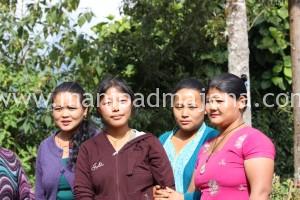
Not waiting for separate climate adaptation funds, but converging with government programmes
Also, the Sikkim government by integrating MGNREGA, a major national government rural employment guarantee programme, into the trench digging component of the spring-shed programme, has not only involved communities through the wage income but has enhanced their knowledge and sense of ownership in managing their water resources.
The cost of reviving the springs has been comparatively low as the trench digging component has been borne under MGNREGA. The water storage tanks, one each for ten households livelihood assets created in their lands, have also been constructed under the central government scheme.
This model of integration offers a replicable template for other States for self sustainable climate adaptation without external resources.
Hurdles on the way of springs’ revival
While spring water is perceived as a public resource, the majority of the springs and their recharge areas are on privately owned land. Land acquisition for the rainwater harvesting trenches is a major hurdle in reviving springs in Sikkim.
“When the aquifers run under private land, many a land owner does not give land use permission because the beneficiaries are not his family but others residing lower down the mountain,” says Benu Gurung, a State administrative officer .
“Sometimes even if private owners allow their land to be used, on their death their inheritors withdraw permission,” Pem Norbu added.
To circumvent this hurdle, the government has allowed forest land, normally not diverted for other land use, to be utilized for the spring-sheds,” Gurung says.
“There are a number of hydel power projects in the pipeline in Sikkim while a few have already been commissioned. Studies are needed to understand their impact on spring flow,” Tambe says.
With the region getting drier and warmer, forest fires are now more frequent. Their effect on Himalayan springs too needs more clarity. Pem Norbu adds that the humidity from the watershed trenches dug for spring revival are acting as retardant for forest fires.
By: Manipadma Jena

